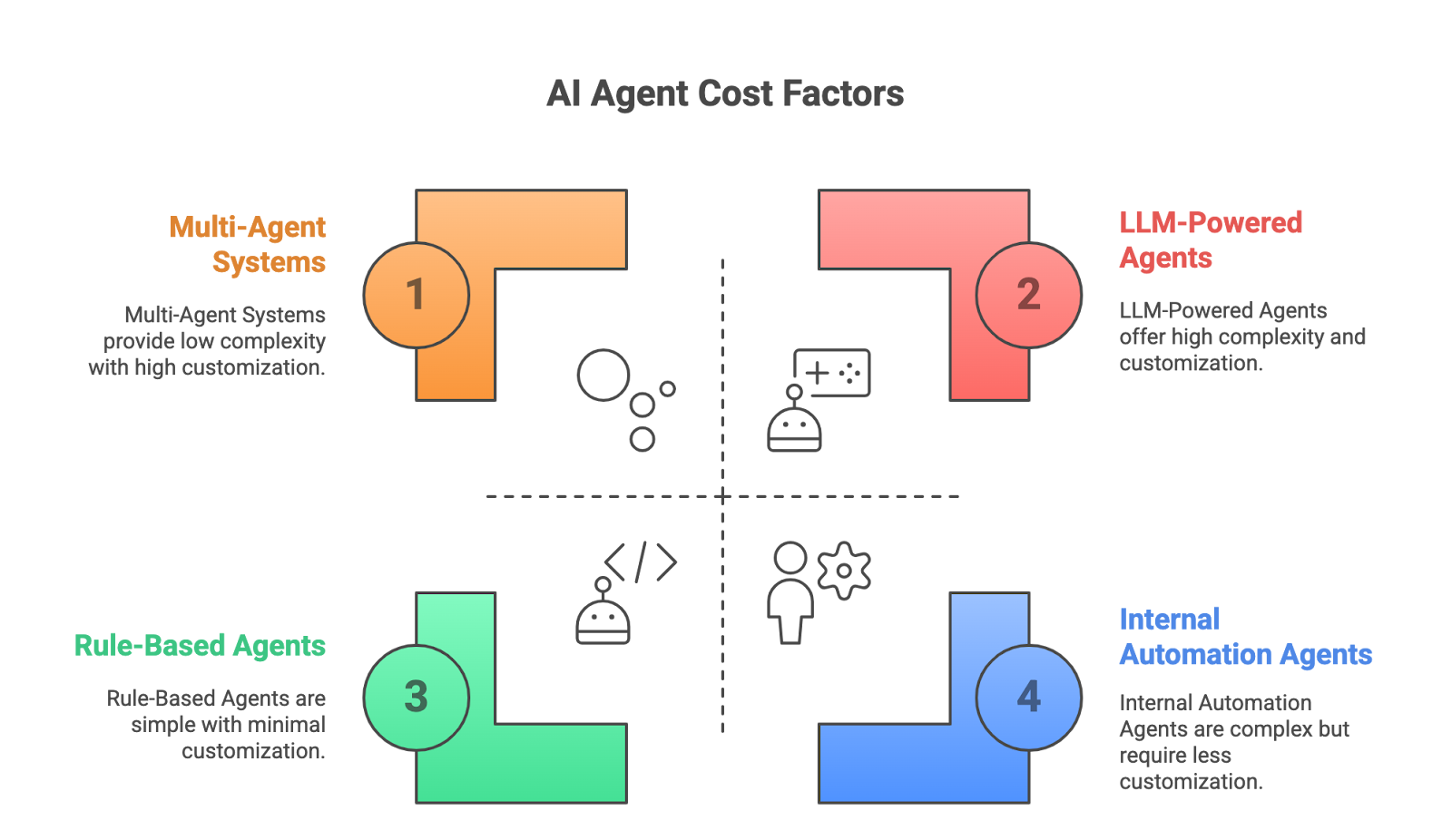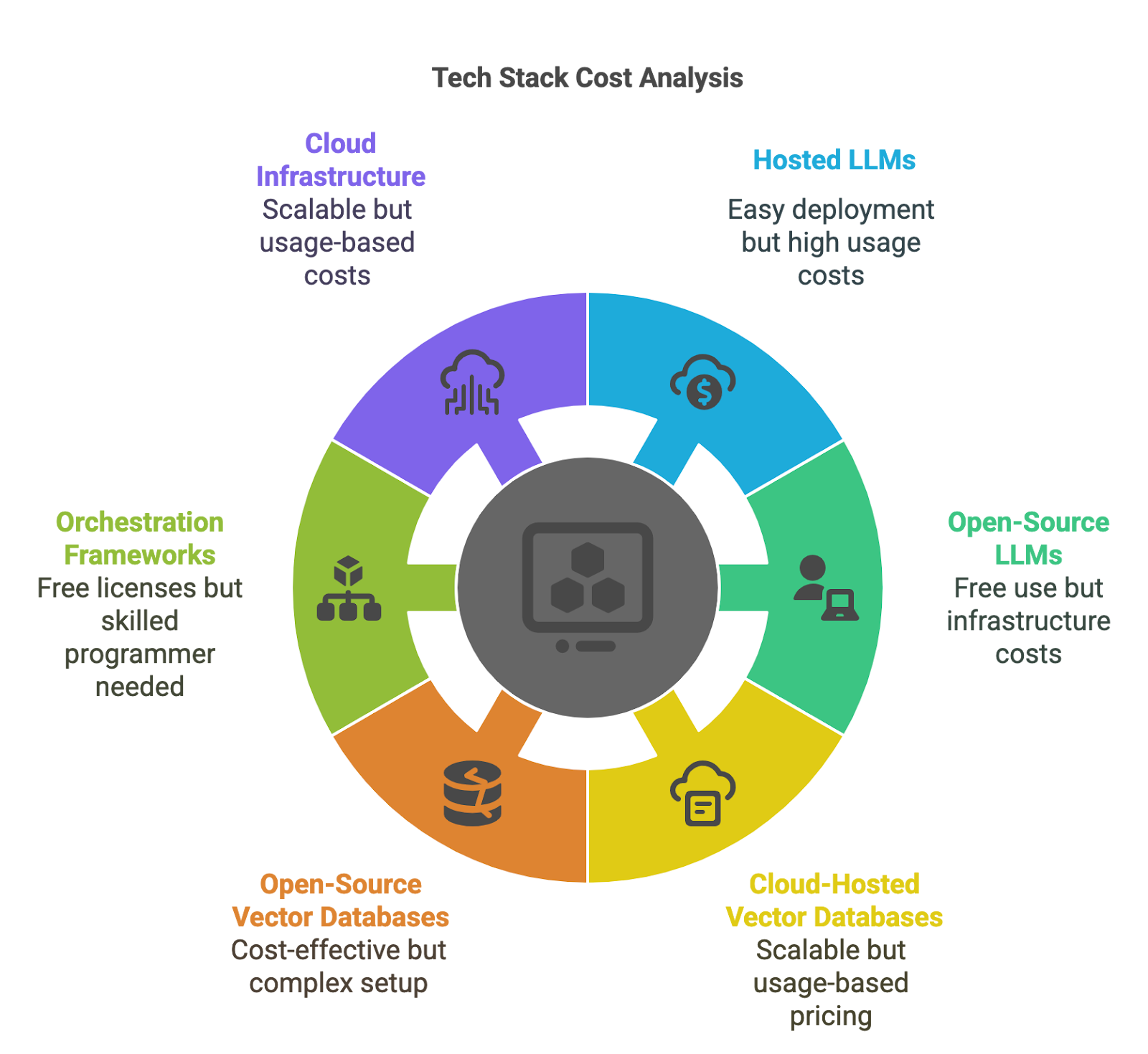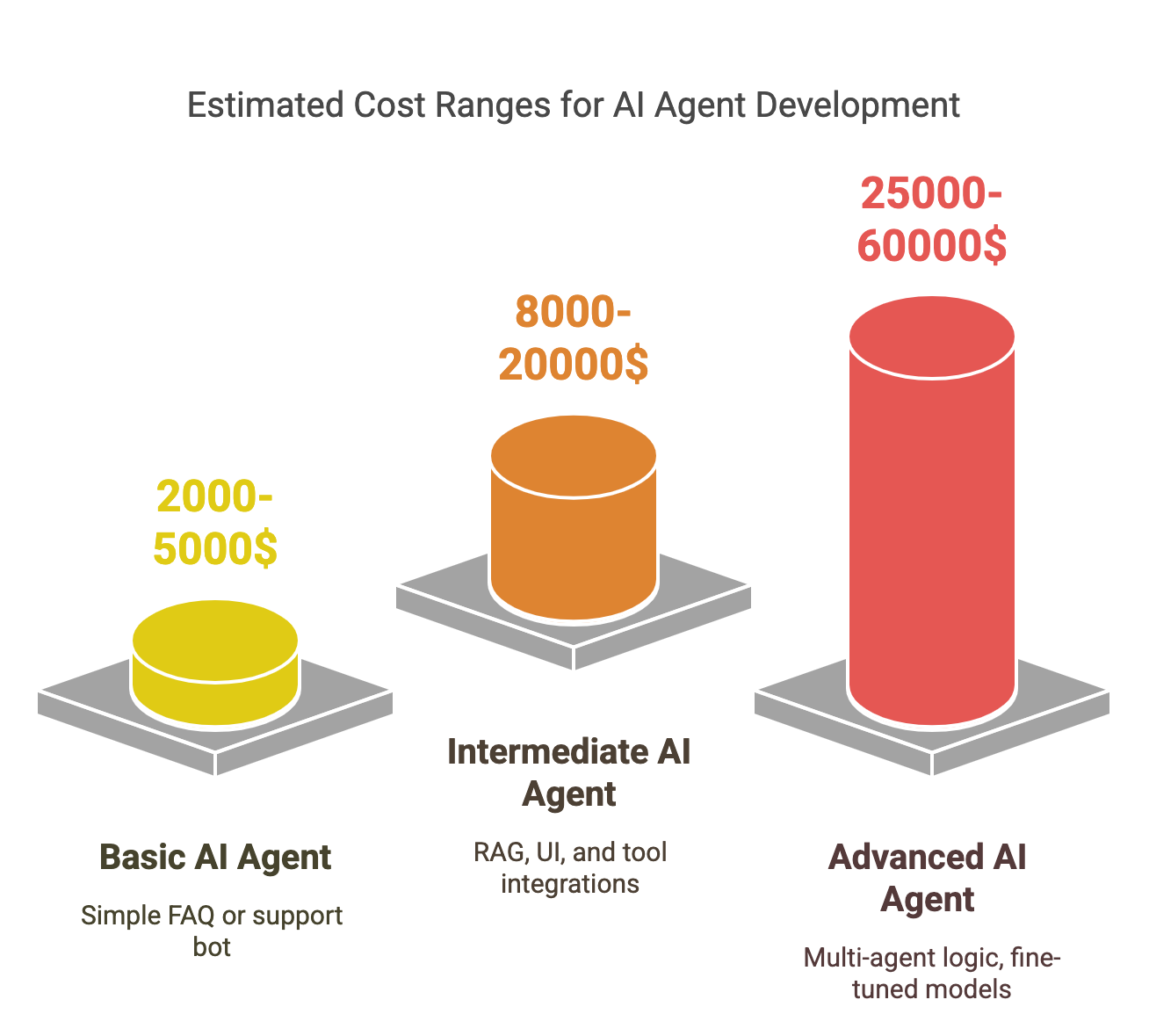|
Getting your Trinity Audio player ready...
|
By 2025, you will witness AI agents revolutionising operational processes in organisations worldwide. From automated customer support to workflow management internally in companies and even powering intelligent virtual assistants, AI agents are increasingly allowing organisations to optimise their processes, cut costs, and improve the delivery of a seamless user experience.
Startups and enterprises want AI to continue positioning themselves to compete in an evolving economy driven by digitisation. Now, one can utilize an AI agent in a remarkably straightforward manner as the power and availability of large language models (LLMs) continue to strengthen, making development even more accessible through frameworks such as LangChain and LlamaIndex.
However, one question remains: What is the cost to build an AI agent?
The answer is rather delicately nuanced. The complexity of the agents, the technologies involved, and their customisability will determine AI development pricing quite significantly. Founders, product managers, and innovation leaders must understand the pricing structure in AI agent development to ensure effective planning and budget allocation.
Factors That Affect the Cost of Building an AI Agent

The cost to build an AI agent is determined by many factors, starting with the type, extending to the case for its use and complexity, and finally, by exploring the extent or degree of personalisation needed.
Type of AI Agent
Rule-Based Agents: These agents follow a simpler, predefined tree of logic and are fundamentally less complex than other types of AI agents. They are fit for basic support tasks but do not extend much in their field. Also, building these would be the least expensive.
LLM-Powered Agents: These agents are based on models such as OpenAI’s GPT-4/5 or any other open-source alternative. They are pretty flexible but are, of course, much costlier—initially and on an ongoing basis.
Multi-Agent Systems: These are really advanced AI setups, with all the specialised agents working together for a task (e.g., planner, executor, validator). These systems are indeed compelling, but they are also extremely complex and pricier.
Use Case and Business Function
- Customer Support Bots: These automate FAQs and triage support tickets.
- Lead Generation Bots: Connect and qualify prospects on a website or application.
- Internal Automation Agents: Aid teams in retrieving information, generating reports, or automating workflows.
Complexity and Integration Requirements
More sophisticated tasks require higher investment costs. Those agents that integrate with third-party platforms (CRM, ERP, support ticketing tools) demand much stronger backend development and API effort. Custom workflows and automation logic make the task heavier.
Customization and Domain-Specification
We can develop a ready-to-use general-purpose agent fairly quickly. But for the fine-tuning of a specialised business domain such as finance, healthcare, or law, a specifically trained model trained on proprietary datasets must be used, which will increase development time and cost.
Understanding these foundational elements is the first step toward estimating AI agent pricing 2025.
Development Cost Breakdown
The process of building an AI agent is segmented into several stages, each contributing to the overall expense. By comprehending the breakdown of AI agent pricing for 2025, you can set priorities for columns and expenses and identify potential areas for reduction.
Planning and Strategy
This phase involves defining the objectives for the agent, mapping workflows, and determining its core functions. User persona development and technical feasibility analysis also fall into this phase. The planning could cost, depending upon how deep you want to go, anything ranging between $500 and $3,000.
Model Selection
Now, you must decide whether you want to use hosted LLMs (like GPT-4 of OpenAI) or an open-source model (such as Mistral or LLaMA) instead of training your model. Hosted APIs are cheaper for the initial set-up but will incur charges as you start using them, while fine-tuning or training a model, on the other hand, would require considerable investments from the outset, which could then save costs in the long run. Depending on the model and level of customisation, these investments can range from $1,000 to more than $10,000.
Knowledge Base and Retrieval System
If your agent requires up-to-date knowledge, you’ll need to implement a retrieval-augmented generation (RAG) pipeline. This involves gathering, cleaning, and structuring your data and then indexing using a vector database. Popular tools to use include Pinecone, Weaviate, and FAISS. Expect this stage to cost $2,000 to $8,000.
User Interface Design
The front-end interface can take the form of a chatbot widget, a mobile app, or an embedded API. Design and development costs for a responsive, intuitive UI typically fall in the range of $1,000 to $5,000, depending on the complexity and platform.
Frontend and Backend Development
Developing the communication layer, setting up APIs, and building admin dashboards or reporting tools form the backbone of your AI agent. This part of the build typically costs between $3,000 and $15,000, with higher-end systems needing real-time processing and multi-threaded logic.
Third-Party Integrations
Many businesses require their agents to connect with platforms like HubSpot, Salesforce, Slack, Notion, or internal databases. Integration development can range from $1,000 to over $10,000, depending on the number and complexity of systems involved.
Testing and Deployment
Before launching, your agent must undergo rigorous testing. This includes stress testing, scenario simulation, user testing, and quality assurance. The cost of testing and deployment usually runs between $1,000 and $4,000.
Ongoing Maintenance and Monitoring
Post-launch, your AI agent requires continuous monitoring, updates to prompts or workflows, performance improvements, and occasional retraining or fine-tuning. Monthly maintenance costs generally fall between $500 and $2,000.
Tech Stack and Its Impact on Cost

Even the type of technology stack selected bears a significant influence on the upfront and ongoing costs of development.
Hosted vs Open-Source LLMs
Hosted models render deployment more effortless, facilitating better scalability, but they generally charge by token, which can be quite a significant sum when used heavily. On the other hand, open-source models license free use for the developers. The greatest disadvantage is that these models may require substantial support infrastructure, usually in the form of cloud GPUs, which can lead to significant setup and operational costs.
Vector Databases
Vector databases allow your AI to “remember” or retrieve data from context. Some agents, like Pinecone and Weaviate, offer cloud-hosted solutions and usage-based pricing. The self-hosting option is open-source components like FAISS. AI development pricing varies, but many providers will charge a service fee ranging from $50 to over $1,000 per month based on volume and performance requirements.
Frameworks and Orchestration Tools
LangChain, LlamaIndex, and Haystack constitute the most popular orchestration frameworks and assist in the building of LLM workflows and connections to external tools. Many of them might offer free or open-source licenses, but a skilled programmer is still needed to harness them efficiently.
Cloud Infrastructure
Cloud providers, such as AWS, Azure, and Google Cloud, provide the backbone for the hosting of your app, vector database, and the AI model (if self-hosted). These costs are usage-based and typically scale with user volume and model complexity.
Estimated Cost Ranges (By Complexity)

To give you a better idea of what to expect, here’s a breakdown of AI agent development costs based on common project scopes:
- Basic AI Agent (FAQ or support bot)
The basic AI agent is built using LLM APIs and has a simple frontend. The basic AI agent does not require any complex integrations.
Estimated Cost: $2,000 to $5,000 - Intermediate AI Agent (RAG, UI, and tool integrations)
This includes retrieval systems, vector search, and integration with external tools or databases.
Estimated Cost: $8,000 to $20,000 - Advanced AI Agent (multi-agent logic, fine-tuned models, custom dashboards)
This involves the training or fine-tuning of custom models, multi-agent systems, and tailored interfaces.
Estimated Cost: $25,000 to $60,000 or more
Keep in mind that hosted models like OpenAI come with ongoing usage costs, often priced per 1,000 tokens. If your app processes high volumes of data or user requests, these charges can become a significant recurring expense.
In-House vs. Outsourced Development Costs
This factor significantly impacts your budget when deciding between in-house development and contracting a specialised development team to build your AI agent.
Internal Development
Hiring full-time developers and AI specialists can propel your idea forward, providing complete control and a long-term investment in your tech stack. However, the initial startup costs run much higher. Such average experienced AI engineers would draw salaries ranging from $120,000 to $200,000 per annum, depending upon the region of the US or Western Europe, excluding all the benefits and infrastructure. Outsourced Development:
Outsourcing Development Associates
Work with any agency or a freelance AI expert from anywhere in a country where labour is a lot cheaper, such as India, Eastern Europe, or Southeast Asia, and save between 40% and 70% on development costs. Then, you get to hire experienced professionals without the long-term commitment of a full-time hire. Ultimately, the decision depends on your internal resources’ capabilities, the project’s scope, and your budgetary constraints. For most startups, outsourcing is the best way to quickly and cheaply launch an AI MVP.
Tips to Reduce AI Agent Development Costs
Entrepreneurs and product managers, who strive to maximise value, can reduce development costs in several ways without compromising quality.
- Start with a Minimum Viable Product
Focus on core functionality first. Use early feedback to guide further development.
- Use open-source models wherever possible
Deploying models such as LLaMA or Mistral can eliminate API token costs, although these models may require more effort to set up.
- Avoid Fine-tuning unless unavoidable
Pre-trained models are good enough for most applications, and private training should only serve highly niche domains.
- Automate Knowledge Base Creation
Scripts or scrapers should be used to collect and index various internal documents, FAQs, and support content.
- Prospect the stack wisely
Not every project requires LangChain or Pinecone. Some simpler alternatives may suffice for a lower cost.
Why Esferasoft is the Right Partner for Your AI Agent Development
Creating an AI agent is not mere coding; it is understanding the business aligned with its goals and creating intelligent systems that provide real-life solutions. Esferasoft specialises in building all kinds of scalable, business-first, practical AI-driven solutions.
Here’s how Esferasoft can be of help to you:
- Access Knowledge in AI and LLM Integration
Our team has hands-on experience working with hosted and open-source LLMs: OpenAI, Mistral, and LLaMA models. Whether it’s an uncomplicated support bot or a sophisticated multi-agent system, we do help you choose the right model and tech stack to minimise costs and maximise performance.
- Complete Development Services
We offer complete development services for creating AI agents, from the initial strategy and planning to deployment and after-launch support. The AI bot cost estimates we develop are not mere bots but full ecosystems integrated with all existing tools and workflows.
- Economical and Scalable Solutions
We provide high-quality development services at affordable rates to both startups and multinational firms worldwide. Using sustainable frameworks like Langchain, LlamaIndex, and R.A.G. pipelines, we create agents that are superb and cost-efficient.
- Industry-Specific Tailoring
Our AI bot cost estimate offers expertise that stretches across a range of areas, including eCommerce, healthcare, finance, legal tech, and more. Different industries have subtle differences; therefore, we will be able to fine-tune the AI agents to handle your specific workflows, terminology, and compliance requirements.
- Global Trust, Local Support
Esferasoft is trusted for its high reliability, transparency, and long-term relationships with clients in North America, Europe, and Asia. We offer flexible engagement models suitable for your project timeline and budget.
If you are searching for a trusted technology partner to help bring your AI vision to reality, Esferasoft is ready to guide you through the transition into the AI landscape.
Budget with Confidence, Build with Purpose
As far as today goes, as far as modern business concerns, AI agents are becoming their lifeblood—the much-touted potential of an AI agent transforms customer engagement, and internal operations can now be automated, all depending, however, on the customer’s understanding of the true cost and scope of development.
In 2025, it would probably cost a certain amount to build an AI agent that will accomplish the set goals, technical requirements, and available resources. Whether designing a simple chatbot or an expansive multi-agent system, strategic planning and informed decision-making are vital to reap strong returns on investment.
Are you looking for a cost-effective AI agent? Let’s make one according to your needs. [Talk to our experts today]

